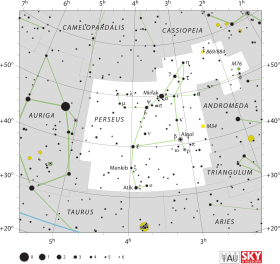V392 Persei
| Observation data Epoch J2000.0 Equinox J2000.0 | |
|---|---|
| Constellation | Perseus |
| Right ascension | 04h 43m 21.37s[1] |
| Declination | +47° 21′ 25.9″[1] |
| Apparent magnitude (V) | 6.3 - 16.9[2] |
| Characteristics | |
| B−V color index | +1.0[3] |
| V−R color index | +0.9[3] |
| Variable type | dwarf nova & nova[1] |
| Absolute magnitude (MV) | −10.1 (max)[6] |
| Database references | |
| SIMBAD | data |
V392 Persei, also known as Nova Persei 2018, is a bright nova in the constellation Perseus discovered on April 29, 2018. It was previously known as a dwarf nova.
Dwarf nova
A U Geminorum-type variable star or dwarf nova is a type of
hydrogen-alpha (Hα) and both neutral and ionised helium.[3] The brightest recorded observations is at magnitude 5.6.[6]
Nova eruption
AAVSO
dataOn April 29, 2018 it was discovered by Yuji Nakamura to be extremely bright, and it was spectroscopically confirmed as a nova outburst with magnitude 6.2 on April 30. The spectrum includes broad Hα and
blueshifted by a velocity of 2,680 km/s, which would be the expansion velocity from the nova explosion.[9]
Observations with
gamma-ray source at the coordinates of the nova.[10] Photometry of the nova from Konkoly Observatory on May 1, 2018 give apparent magnitudes of 7.38 in the V band and 8.22 in the B band, suggesting it is already declining.[11]
System
V392 Persei is the southern of a pair of stars separated by 8.5".[2]
The
Gaia parallax.[6]
Gallery
-
Dwarf nova V392 Persei over the ESO Supernova Planetarium & Visitor Centre.[13]
-
V392 Persei, 2 May 2018, 22:00 UT. The slightly fainter nearby star is 9th magnitude BD+47°1026. Up is approximately east.
See also
References
- ^ Bibcode:2009yCat....102025S.
- ^ Bibcode:2006SASS...25...47W.
- ^ doi:10.1086/313380.
- ^ .
- S2CID 118925493.
- ^ S2CID 119486187.
- ^ "V392 Per". SIMBAD. Centre de données astronomiques de Strasbourg. Retrieved 2019-08-25.
- ^ N.N. Samus; O.V. Durlevich (February 12, 2009). "GCVS Variability Types and Distribution Statistics of Designated Variable Stars According to their Types of Variability". Retrieved 2013-02-08.
- ^ R. M. Wagner; D. Terndrup; M. J. Darnley; S. Starrfield; C. E. Woodward; M. Henze. "Optical Spectroscopy of TCP J04432130+4721280 (V392 Per) Confirms a Nova Eruption". Retrieved 2018-05-02.
- ^ Kwan-Lok Li; Laura Chomiuk; Jay Strader. "Bright gamma-ray emission from TCP J04432130+4721280 (V392 Per) detected by Fermi-LAT". Retrieved 2018-05-02.
- ^ R. Konyves-Toth; B. Csak; A. Pal; J. Vinko. "Optical Photometry of the Nova Outburst TCP J04432130+4721280 (V392 Per)". Retrieved 2018-05-02.
- S2CID 235632263.
- ^ "Nova over Supernova". www.eso.org. Retrieved 7 May 2018.
External links
- Dwarf Nova V392 Persei Goes Big — It’s Now Binocular Bright
- How A Dwarf Nova Hit The Big Time May 2, 2018
- Nova in Perseus
- V392 Per in outburst, showing spectra of the nova in outburst and previously


![Dwarf nova V392 Persei over the ESO Supernova Planetarium & Visitor Centre.[13]](http://upload.wikimedia.org/wikipedia/commons/thumb/e/e3/Nova_over_Supernova.jpg/120px-Nova_over_Supernova.jpg)


